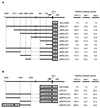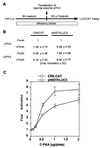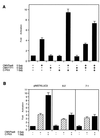The paired-domain transcription factor Pax8 binds to the upstream enhancer of the rat sodium/iodide symporter gene and participates in both thyroid-specific and cyclic-AMP-dependent transcription
- PMID: 10022892
- PMCID: PMC83998
- DOI: 10.1128/MCB.19.3.2051
The paired-domain transcription factor Pax8 binds to the upstream enhancer of the rat sodium/iodide symporter gene and participates in both thyroid-specific and cyclic-AMP-dependent transcription
Abstract
The gene encoding the Na/I symporter (NIS) is expressed at high levels only in thyroid follicular cells, where its expression is regulated by the thyroid-stimulating hormone via the second messenger, cyclic AMP (cAMP). In this study, we demonstrate the presence of an enhancer that is located between nucleotides -2264 and -2495 in the 5'-flanking region of the NIS gene and that recapitulates the most relevant aspects of NIS regulation. When fused to either its own or a heterologous promoter, the NIS upstream enhancer, which we call NUE, stimulates transcription in a thyroid-specific and cAMP-dependent manner. The activity of NUE depends on the four most relevant sites, identified by mutational analysis. The thyroid-specific transcription factor Pax8 binds at two of these sites. Mutations that interfere with Pax8 binding also decrease transcriptional activity of the NUE. Furthermore, expression of Pax8 in nonthyroid cells results in transcriptional activation of NUE, strongly suggesting that the paired-domain protein Pax8 plays an important role in NUE activity. The NUE responds to cAMP in both protein kinase A-dependent and -independent manners, indicating that this enhancer could represent a novel type of cAMP responsive element. Such a cAMP response requires Pax8 but also depends on the integrity of a cAMP responsive element (CRE)-like sequence, thus suggesting a functional interaction between Pax8 and factors binding at the CRE-like site.
Figures









Similar articles
-
A thyroid-specific far-upstream enhancer in the human sodium/iodide symporter gene requires Pax-8 binding and cyclic adenosine 3',5'-monophosphate response element-like sequence binding proteins for full activity and is differentially regulated in normal and thyroid cancer cells.Mol Endocrinol. 2002 Oct;16(10):2266-82. doi: 10.1210/me.2002-0109. Mol Endocrinol. 2002. PMID: 12351692
-
The CRE-like element inside the 5'-upstream region of the rat sodium/iodide symporter gene interacts with diverse classes of b-Zip molecules that regulate transcriptional activities through strong synergy with Pax-8.Mol Endocrinol. 2004 Nov;18(11):2817-29. doi: 10.1210/me.2004-0020. Epub 2004 Aug 19. Mol Endocrinol. 2004. PMID: 15319451
-
NF-kappaB p65 subunit mediates lipopolysaccharide-induced Na(+)/I(-) symporter gene expression by involving functional interaction with the paired domain transcription factor Pax8.Mol Endocrinol. 2010 Sep;24(9):1846-62. doi: 10.1210/me.2010-0102. Epub 2010 Jul 28. Mol Endocrinol. 2010. PMID: 20667985 Free PMC article.
-
Molecular events in the differentiation of the thyroid gland.J Endocrinol Invest. 1995 Feb;18(2):117-9. doi: 10.1007/BF03349716. J Endocrinol Invest. 1995. PMID: 7629376 Review. No abstract available.
-
Molecular events involved in differentiation of thyroid follicular cells.Mol Cell Endocrinol. 1998 May 25;140(1-2):37-43. doi: 10.1016/s0303-7207(98)00027-6. Mol Cell Endocrinol. 1998. PMID: 9722166 Review.
Cited by
-
Evidence for transcriptional and posttranscriptional alterations of the sodium/iodide symporter expression in hypofunctioning benign and malignant thyroid tumors.Am J Pathol. 2004 Jul;165(1):25-34. doi: 10.1016/S0002-9440(10)63272-5. Am J Pathol. 2004. PMID: 15215159 Free PMC article.
-
Expression and function of the homeodomain-containing protein Hex in thyroid cells.Nucleic Acids Res. 2000 Jul 1;28(13):2503-11. doi: 10.1093/nar/28.13.2503. Nucleic Acids Res. 2000. PMID: 10871399 Free PMC article.
-
The solution structure of DNA-free Pax-8 paired box domain accounts for redox regulation of transcriptional activity in the pax protein family.J Biol Chem. 2008 Nov 28;283(48):33321-8. doi: 10.1074/jbc.M805717200. Epub 2008 Sep 30. J Biol Chem. 2008. PMID: 18829450 Free PMC article.
-
Thyroid-specific transcription factors and their roles in thyroid cancer.J Thyroid Res. 2011;2011:710213. doi: 10.4061/2011/710213. Epub 2011 Apr 28. J Thyroid Res. 2011. PMID: 21687604 Free PMC article.
-
Left ventricular remodeling in swine after myocardial infarction: a transcriptional genomics approach.Basic Res Cardiol. 2011 Nov;106(6):1269-81. doi: 10.1007/s00395-011-0229-1. Epub 2011 Nov 5. Basic Res Cardiol. 2011. PMID: 22057716 Free PMC article.
References
-
- Aza-Blanc P, Di Lauro R, Santisteban P. Identification of a cis-regulatory element and a thyroid-specific nuclear factor mediating the hormonal regulation of rat thyroid peroxidase promoter activity. Mol Endocrinol. 1993;7:1297–1306. - PubMed
-
- Boshart M, Kluppel M, Schmidt A, Schutz G, Luckow B. Reporter constructs with low background activity utilizing the cat gene. Gene. 1992;110:129–130. - PubMed
-
- Brindle P, Montminy M. The CREB family of transcription activators. Curr Opin Genet Dev. 1992;2:199–204. - PubMed
Publication types
MeSH terms
Substances
Associated data
- Actions
Grants and funding
LinkOut - more resources
Full Text Sources
Other Literature Sources
Miscellaneous
